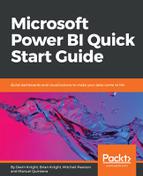If you're a traditional BI developer who has built Reporting Services reports, you might feel right at home with Power BI Report Server, as the configuration and portals were largely borrowed from Reporting Services. The main difference is that you will not use Visual Studio to build reports. You're going to use a special Power BI desktop that is optimized for the server. The main reason for the separate desktop is to ensure that the desktop doesn't promote a feature that the server does not support. One key advantage to using this approach is that Report Server can also host your traditional Reporting Services reports, KPIs, and mobile reports.
Before deploying your report, you may want to create some folders to simplify finding your reports later. For example, creating a folder for finance, HR, inventory, IT, operations, and sales is a common starting point. Don't worry: you can always move the reports later if you've already deployed them. Once you've created a folder, if you feel it's needed, you can deploy your Power BI reports in one of two ways: from the Power BI desktop or by uploading.
Make sure you have an Power BI desktop installed that supports Power BI Server and open the report that you wish to deploy. This flavor of Power BI Desktop also supports deploying to the cloud if you need a single experience, but note that you will be at least 3–4 months behind the main Power BI application. Next, click File | Save As | Power BI Server. If this is your first time deploying your report to the server, everything will be blank. Simply type the Report Server HTTP address in the box to connect to the Power BI Server. It should look something like http://servername/reports. If you have a port number, you'll need to use something like http://servername:portnumber/reports. You can find the exact location to enter by going to your Report Server Configuration Manager tool from the server and copying the URL from the Web Portal URL section. The port in this screenshot is port 80, which you don't have to enter as it is the default port:

If the desktop can successfully connect to the server, you will be prompted for the folder name that you want to deploy to and the name of the report you want to use. Typically, you don't want to use this opportunity to change the name of the report since it will become difficult to find your source report later. After clicking OK, the report will deploy and provide you a link that will take you directly to the report that now resides on your server. From this point forward, you can click Save without going through this process and it will save directly to the server.
You can also upload the report directly in the browser. To do this, simply go to the folder you wish to upload the report to and click Upload in the top-right corner. You will then be prompted for the location of the folder, and then you're done. Power BI Server will scan to make sure that the report is compatible. For example, if you built the report on a very new version of Power BI Desktop that is using features that aren't supported in Power BI Server yet, then you will receive an error before the upload occurs. Once the report is deployed, any user with the appropriate access can also click the Edit button in Power BI Desktop to open the report up in the desktop so that they can make changes.
If you wish to move the report to a new folder, you can go to the report listing and click Move under the ellipsis button. You will be prompted for the folder you wish to move the report to, and then you're done. You can also do this under Manage in the same ellipsis.
In the Manage area of a report, you can also hide the report by clicking Hide this Object. This can be used to hide reports that are built on other reports, for example. It's important to note, though, that this is not a security mechanism. There's nothing to stop a user from seeing the report if they unhide the object.
